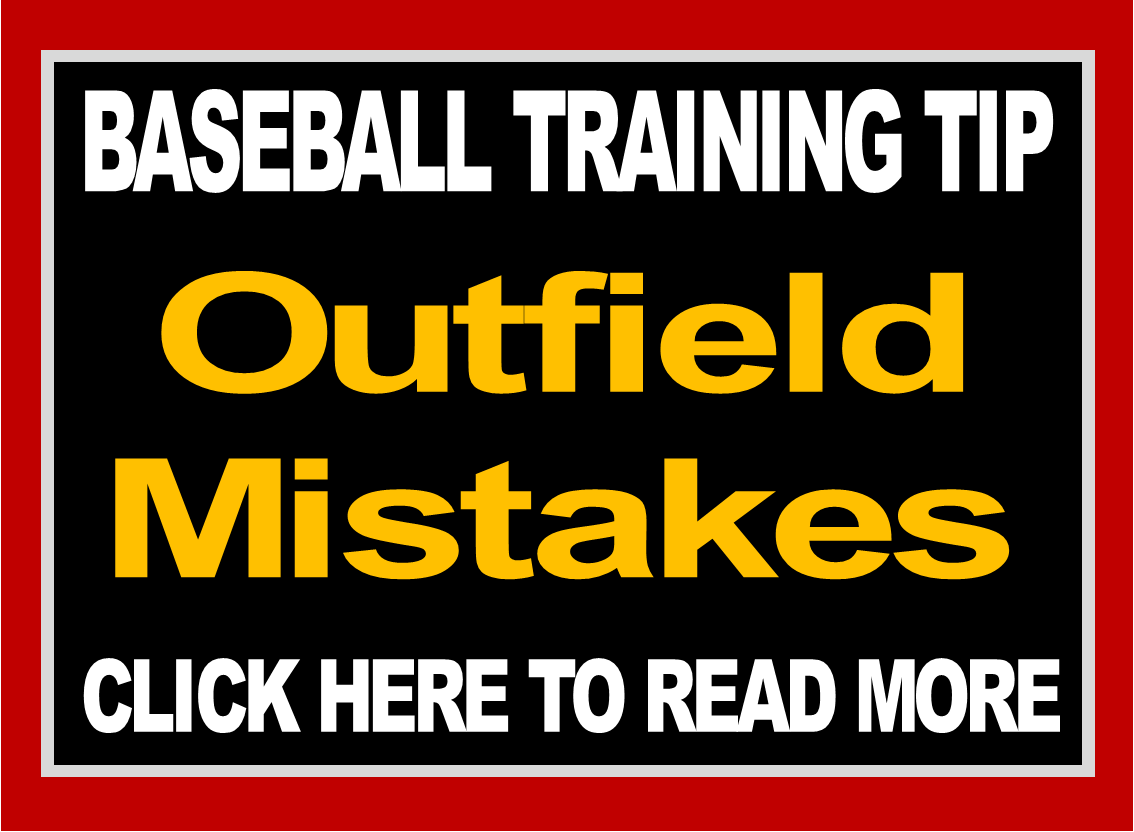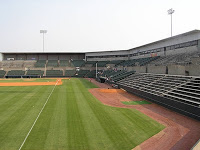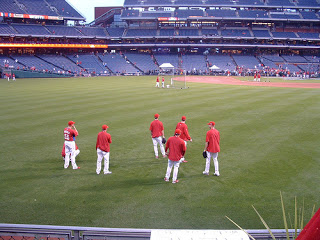
21 Jun Outfield Mistakes
Left Field Mistakes
Allowing too many batters to get to second base. This mostly applies to balls hit down the left field line that aren’t hit hard enough to reach the corner. It’s a play where the batter tries to stretch a base hit into a double. The mistake
left fielders make is being too slow in getting to these balls making it more likely the batter-runner will take the chance in going to second. Many times the left fielder incorrectly assumes the batter will stay at first and takes his time. Other times the batter-runner may know the left fielder’s arm strength is a little short and tries to take advantage. Either way, the left fielder must attack all balls hit to this area to get to them as quickly as possible. A batter-runner who rounds first base and sees the left fielder in the process of throwing to second will most likely stop at first. If he rounds first and the left fielder has not yet reached the ball, he will most likely try for second base and probably will make it there. Left fielders need to get to the ball and get rid of it as fast as they can.
Throwing to the cut-off man. This refers to two separate plays in which the left fielder is involved. The first involves the play explained above where the batter-runner attempts to stretch a single into a double. The second involves a throw to home plate to cut down a runner trying to score. The source of the mistake involves the difference between the phrases “throwing to the cut-off man” and “throwing through the cut-off man.” When players are younger, their lack of arm strength generally prevents them from throwing from left field all the way to second base without using the shortstop as a cut-off man. The same holds true for throws to home with the third baseman as the cut-off. Kids are therefore taught to “hit the cut-off man” with all throws. As stated in previous posts, the game gets faster as players get older. As a result, the left fielder eventually must be able to reach the base they are throwing to without the need for a cut-off man. However, many older kids with enough arm strength still have this “throw it to the cut-off man” mentality instead of the “throw it through the cut-off man” mind set. Adding a cut-off man increases the time it takes for the ball to reach its destination. Ideally, all throws should be low enough so that the cut-off man is capable of cutting it but strong enough to reach the base on its own as well.
Too much respect for the shortstop and center fielder. In comparison, the left fielder is usually the less talented outfielder of the three all things considered. Of course, there are always exceptions to this. On the other hand, the center fielder and shortstop are frequently the two best overall defensive players on the field. Sometimes this impacts how left fielders go after fly balls. If the left fielder knows that the shortstop and center fielder are talented, they sometimes assume those other guys will get the ball more easily. Therefore, the left fielder gives up on going for the ball too soon. To complicate matters further, many coaches stress that center fielders have priority if two outfielders both go after a fly ball. Although this is true, some left fielders become too timid on all fly balls as a result. The best left fielders know when to back off and when to attack the fly balls they are responsible for catching.
Too deep with a runner on second, two outs. As stated above, many times the left fielder is not the best defensive outfielder of the three. This of course may apply to arm strength as well. Especially with two outs, many left fielders play too deep with a runner on second base. Since there are two outs, the runner on second will start running at contact and therefore has a better chance of scoring on a hit. This is why left fielders sometimes should play a little more shallow – especially if their arm strength is a bit short. The obvious risk that comes with this is that balls can be more easily hit over their head. However, with two outs, the left fielder needs to be in a better position to give himself a chance to throw out a runner at home. The score, the inning, and who is batting also play a factor so understand that it is never as clear cut a rule as it may sound.
Center Field Mistakes
Too timid. The last thing a center fielder should be is too timid. They are playing center field for a reason. Someone thought they could cover the most ground and probably thought they had the most athleticism and speed among the three outfielders as well. A fearless aggression is essential for a center fielder to move from good to great. Premiere center fielders take it personally if any ball drops in their territory without being caught. They certainly have the most territory to cover so any hesitation in their first step jumps and approaches to fly balls will prove costly. They want the ball hit to them and they expect to track it down every time.
Too deep. There are coaches who probably would disagree with this but I believe many center fielders, especially at the high school level, play too deep. Upwards of 75% of the game of baseball occurs in the infield. Taking this into account, most balls hit to center field are going to be in front of the center fielder. Playing more shallow allows the center fielder to be in a position to catch more line drives and bloop hits that fall into shallow center field. A couple reasons why center fielders play deeper is because they are more comfortable moving forward on a hit ball and fear a ball will land over their head for extra bases. This certainly will happen every once in awhile but the benefits of reaching more balls in shallow center outweigh the few balls hit over their head. At least in my opinion. Keep reading to see what can help a center fielder gain more confidence on balls hit over his head.
Too lazy during batting practice. The first two mistakes so far have been playing too timid and playing too deep. Practicing outfield work during batting practice is single handedly the best way for any center fielder (and other
outfielders as well) to correct these mistakes and improve their defense. Having coaches hit fly ball after fly ball is no replacement for reading the baseball off the bat during batting practice. Too many players who are out in the field during batting practice use that time to socialize and hang out until it is their turn to hit. Premiere center fielders use the time differently. They treat it like a game where their job is to get to and catch every ball hit into center field. By doing this, they are getting experience going every which way to get balls, they are working on their jumps, they are anticipating where balls will be hit, and to address the previous mistake, they are working on going after balls over their head. Taking this approach to batting practice gives center fielders more confidence to attack fly balls come game time and also gives them more confidence to play a bit more shallow since they know they can go back well on balls over their head.
Too quiet. Like I mentioned in the post about mistakes catchers make, center fielders need to be the most vocal member of the outfielders. They are the coach in the outfield and should be constantly reminding the other two outfielders of things they need to know. Where batters hit the ball in previous at-bats. Which runners can run and which ones can’t. The score. The outs. Any piece of information that would impact how an outfielder should play should be passed along by the center fielder. College coaches and professional scouts notice that so a center fielder cannot afford to be silent on the field.
Right Field Mistakes
Relying too much on arm strength. Most outfielders eventually find themselves in right field because of their arm strength. Even though all outfielders have similar distances on throws to second base and home plate, it’s the long throw to third base that separates the right fielders from the other two outfielders. The longer throw requires a stronger arm. However, this arm strength can pose a problem for some right fielders. Because they have always had good arms, many of these right fielders have neglected the proper footwork needed to get to a ball and get rid of it quickly. Click here (and scroll down a little) for two examples. Outfielders with less arm strength realize early on that they have to develop proper footwork and technique to make up for a lack of arm strength. Right fielders on the other hand can be more interested in showing off their arms than learning the finer points of playing outfield. Good arm strength and a desire to constantly improve on the little things is what allows right fielders to go from good to great.
Slow to read swings. Great defensive players regardless of position need to be good at anticipating where balls are going to be hit. I addressed this point about anticipating in the posts about shortstops and third basemen but it could apply to everyone else on defense as well. One problem that is uniquely difficult for right fielders is that many balls hit out their way are slicing away from them and towards the foul line. As a result, it is imperative that right fielders become great at reading swings to anticipate where batted balls are most likely to go. This of course helps with getting better jumps on all balls hit but especially those that slice away from them. If a right handed batter fouls off a fastball over the first base dugout, the right fielder should probably interpret that as the batter having slower bat speed. This kind of swing makes it more likely the ball will be hit to right field. The observant right fielder might decide to shift his positioning more towards the right field foul line. A hitter that turns well on a pitch and fouls it down the left field line might signal the right fielder to shift his positioning towards the right-center gap a bit more. The point is to study the swings of all batters to better predict where balls will be hit.
Camping under the ball. This mistake can also be a byproduct of relying too heavily on arm strength when making plays. With runners on base, the fundamentally correct way of catching a routine fly ball is to get behind the ball a few steps and move forward (towards the infield) to catch the ball. This allows their momentum to already be moving towards their throwing target before they catch the ball. When outfielders “camp” under the ball, they are catching the fly ball standing still or even worse, drifting backwards towards the fence. In this scenario, the outfielder needs to waste a lot of time stopping and then changing their momentum in order to throw back to the infield. A player who hustles behind the ball, squares their body up to the infield, and moves forward to catch the ball can catch and complete a strong throw much quicker. Right fielders with strong arms may tend to neglect these fundamentals thinking their arm strength will carry them through instead. This may work at the lower levels but at some point, other teams’ base runners will begin to exploit this weakness.
Making throws tough to handle. Since many right fielders like to show off their arm, many do not focus a lot of attention on the finesse side of their throws. This is similar to a quarterback with a canon for an arm that can easily throw 50 yard passes but not a short screen pass that requires more finesse. Right fielders sometimes forget that there is a teammate on the other end of their throw who would appreciate being given an easy throw to catch so they can apply a tag. The easiest throws to receive as an infielder are those that arrive at the bag in the air or the ones that arrive on a big, easy to handle hop. To show off their arms, many right fielders will launch a throw that ends up “short-hopping” the infielder making it very difficult to catch and make a tag. Should there be a need to one-hop a throw to 2nd base, 3rd base, or home plate, a right fielder (or any outfielder) should throw the ball so that the ball bounces at least 15 feet away from the bag. This will almost always ensure a clean, easy-to-handle hop for the infielder or catcher. It takes some finesse and lots of deliberate practice but your teammates will thank you.





